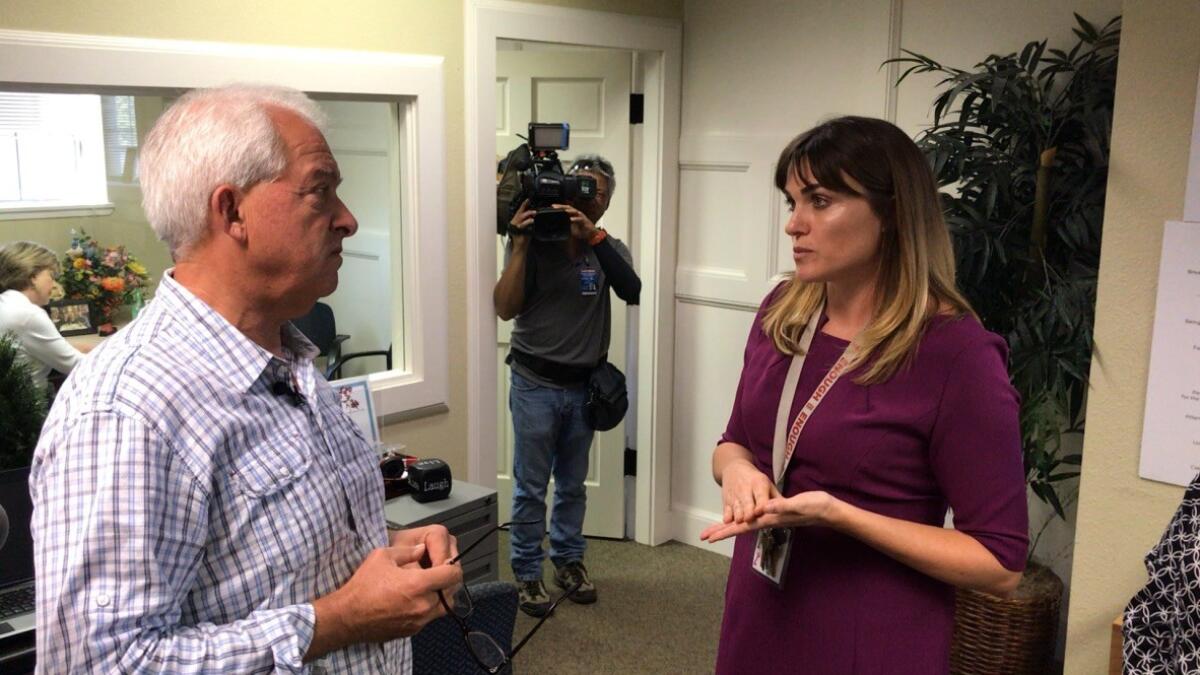Gavin Newsom’s fundraising machine continues to dominate the California governor’s race
- Share via
Reporting from Sacramento — Democratic Lt. Gov. Gavin Newsom heads into the final stretch of the California’s governor’s race holding a mammoth financial advantage over Republican businessman John Cox, with almost 10 times as much money socked away.
The Newsom campaign had $16.2 million cash on hand as of Sept. 22 compared with the $1.7 million Cox had in the bank, according to campaign finance reports filed with the state Thursday evening.
With just more than a month until the Nov. 6 general election, Newsom holds a solid lead in the polls, although a recent survey by the Public Policy Institute of California showed that Cox has narrowed the gap in recent months.
Given that Democrats enjoy a significant advantage over Republicans when it comes to voter registration in California, Newsom’s lead both financially and in the polls could be insurmountable, Chapman University political scientist Lori Cox Han said. But she cautioned that it would be a mistake for Newsom to be overconfident.
“We always used to think whoever raised the most money had such a huge advantage, and I think we’ve seen, certainly in the 2016 presidential race, all of that money didn’t help Hillary Clinton,” she said.
Newsom continues to pocket large donations from past supporters of former Los Angeles Mayor Antonio Villaraigosa, who finished third in the June 5 primary behind Newsom and Cox and failed to advance to the November election.
Those contributors included the Southern California Pipe Trades District 16 council and Tim Leiweke, former president of the Staples Center and Anschutz Entertainment Group, owner of L.A. Live. Both the union and Leiweke donated $29,200 to the Newsom campaign, the maximum allowed per election.
Newsom also received a stream of donations from California Native American tribes that operate casinos, including the Pechanga Band of Luiseño Indians, the Soboba Band of Luiseño Indians and the San Manuel Band of Mission Indians. All donated the maximum amount allowed.

If Newsom is elected governor, part of his responsibilities would be to negotiate tribal-gaming compacts, which lay out the rules and guidelines on how tribal casinos are operated. Those agreements are required before a tribe can offer gaming. Thirty-six tribal-gaming compacts are set to expire in 2020 and could be up for renewal or renegotiation.
Newsom raised $8.7 million from July though Sept. 22, more than twice the $3.8 million raised by Cox during that time.
Still, it was a extremely fruitful fundraising summer for Cox. Before the primary election, Cox’s campaign largely subsisted on the $5.5 million that the wealthy Republican businessman pumped into his bid for governor.
Writing some of the biggest checks to the Cox campaign were Chris Rufer, founder of one of the largest tomato processing companies in the state; Herman Rowland, chairman of the Jelly Belly Candy Co. in Fairfield; and Southern California property developer Michael Mugel, who owns a small stake of LA Weekly’s parent company.
Cox said he is undaunted by Newsom’s financial advantage, criticizing the Democrat for taking money from “special interests.”
“He needs a lot of money to convince people he’s right for the state,” Cox said after he toured a Sacramento homeless shelter, Saint John’s Program for Real Change, on Friday.
The vast majority of the money raised by both candidates will be poured into campaign ads, airing on broadcast and cable stations and popping up on social media platforms such as Facebook.
On Friday, Cox launched a $2-million ad campaign attacking Newsom for being part of California’s Democratic leadership while poverty, homelessness and housing prices exploded in the state.
Newsom began airing a more upbeat campaign commercial earlier this month that was focused on his plans to restore the “California dream,” a media buy costing the campaign in the “seven figures,” said Newsom’s spokesman, Nathan Click.
On Wednesday, Newsom said his campaign will air two more commercials before the Nov. 6 election, describing the ads as “positive about the issues.”
Along with buying air time, most of the Newsom campaign’s expenses over the summer were for polling, fundraising and political consultants. The campaign also donated $200,000 to the California Democratic Party.
The bulk of Cox’s spending over the summer was also for television air time, as well as for radio and digital ads.
Coverage of California politics »
Twitter: @philwillon
Updates on California politics
More to Read
Get the L.A. Times Politics newsletter
Deeply reported insights into legislation, politics and policy from Sacramento, Washington and beyond. In your inbox twice per week.
You may occasionally receive promotional content from the Los Angeles Times.








